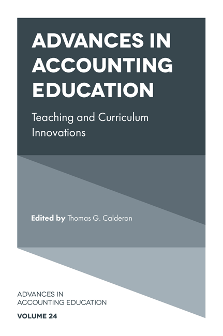
Index
Advances in Accounting Education: Teaching and Curriculum Innovations
ISBN: 978-1-83867-236-2, eISBN: 978-1-83867-235-5
ISSN: 1085-4622
Publication date: 5 October 2020
Citation
(2020), "Index", Calderon, T.G. (Ed.) Advances in Accounting Education: Teaching and Curriculum Innovations (Advances in Accounting Education, Vol. 24), Emerald Publishing Limited, Leeds, pp. 215-219. https://doi.org/10.1108/S1085-462220200000024019
Publisher
:Emerald Publishing Limited
Copyright © 2020 Emerald Publishing Limited
INDEX
- Prelims
- Theme 1: Research on Student Attitudes and Behavior
- Study Choices by Introductory Accounting Students: Those Who Study More Do Better and Text Readers Outperform Video Watchers
- Decade Comparisons: Do Students’ Ethical Attitudes Shift?
- Theme 2: Cases and Pedagogical Approaches in Tax
- Meeting the Demands of the Accounting Curriculum: An Integrated Approach Using a Tax Research Case Assignment
- Bonus Depreciation and its Effect on Net Present Value in Relation to Capital Purchases
- Evaluating the Impact of the VITA Program on Attitudes and Motives Regarding Volunteering and Civic Engagement
- Theme 3: Financial Reporting and Introductory Accounting
- An Instructional Case: Making the Case for Unlimited Vacation Days at Altech
- The Importance of Supplemental Resources in Accounting Education
- Theme 4: Research about the CPA Exam
- Accounting Faculty and Professional Certifications: Experiences and Perceptions
- A Closer Look at Research on CPA Exam Success
- Theme 5: International
- Is the Pause Method in Teaching Auditing Applicable in a Different Educational Environment? A Replication
- Introducing Computer-Marked Tests in an Online Financial Accounting Course: Patterns in Academic Performance and Approaches to Assessment Design
- Index